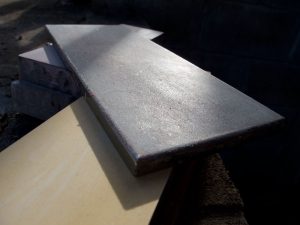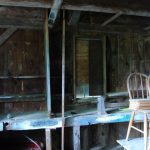We may receive a commission when you use our affiliate links. However, this does not impact our recommendations.
I don’t get too worked up about sharpening equipment. With a few exceptions, any abrasive gets your tools sharp. And I find that the less I write about abrasives, the happier I am.
But I’m going to break my silence to talk about DMT’s Dia-Flat lapping plate. It is awesome – practically perfect. Yes, it is expensive and probably overkill for most home woodworkers. But if you sharpen a lot and are burning through lots of diamond plates or (shudder) wet/dry sandpaper, the Dia-Flat will pay for itself.
What’s so god-awesome about it? It’s the proprietary binder that DMT uses to attach the diamonds to the heavy steel plate. I have been all over the country with this plate. Students at every school have used and abused it. Heck, Roy Underhill used it to flatten all the oilstones at his school.
And the Dia-Flat still works like a champ.
In fact, I’ve been using it as a grinder in the field when there is no electricity or hand-cranked grinder available. I’ve ground high-carbon steel, A2, PM-V11 and D2 on the plate and it hasn’t hurt the thing one bit.
How does it compare to other diamond plates? Well, my opinion is colored by the fact that I am a heavy user. Not only do I sharpen every day, but hundreds of students use my equipment every year.
The Shapton diamond plate is a fine product and many fellow woodworkers love it. I’ve killed two of them by wearing through the diamond plating. The DMT Dia-Sharp plate (the coarse and x-coarse) are probably fine for the home woodworker who is an occasional sharpener, but I’ve killed a couple of these as well. I don’t recommend the imported diamond plates from China. Period.
This year I got a chance to use the iWood/Koyama plates from Tools from Japan. I was impressed with their speed – they were faster than the Dia-Flat – but I have no idea how long they will endure.
I’m sure there are other flattening products out there that I haven’t used. I don’t know if I’ll ever have to try them because I get the feeling that my Dia-Flat is invincible.
— Christopher Schwarz
If you want to learn to sharpen and don’t want to feel like you are getting religion, may I recommend my DVD: “The Last Word on Sharpening”? In it, I show you the principles of sharpening that work with any abrasive and any equipment. You can find it in ShopWoodworking.com.
Here are some supplies and tools we find essential in our everyday work around the shop. We may receive a commission from sales referred by our links; however, we have carefully selected these products for their usefulness and quality.









I may not receive an answer as this post is somewhat old. But, how is everyone’s Dia-Flat plate holding up? I am considering one for waterstone/oilstone flattening. My X-coarse Duo-sharp is running a little light in the grit now a days and may need to retire to flattening only my highest grit waterstones. I personally wish the Dia Flat lapping plate came in a finer grit as 120 micron is far too coarse for my fine waterstones 8000 and above.
Is there any risk of ‘contaminating’ my shapton glass stones if I also use my dia flat on my oil stones (which are polluted with oil and kero)?
Used mine today to flatten my waterstones. Best piece of sharpening equipment I’ve ever bought and I own quite a few including other DMT products. This is by far their best yet. Glad to see I’m not the only one using it for grinding as well. Thanks for the great review Chris. And for those worried about scratching the finer grits just do it. I find the scratches a good way to keep an eye on flatness as they wear off in use. Even if they do make a slight difference to the speed of cut (I didn’t notice) the speed that the dia flat flattens far out weighs any problems from a few small scratches in a fine stone. The scratches may actually be benificial anyway when you really think about it.
Chris,
In your first post regarding the DIA-FLAT, you stated that you use this on all of your Shapton stones. What is the grit range that you have tested, (low – high)?
Will I eventually regret using this on an 8000 Shapton? Too course?
Thanks,
Doug
Chris,
I just got my Dia-Flat and the instructions say to only use water as a lubricant. I am trying to stay away from water. I was curious what you use when you flatten oil stones on your Dia-Flat?
The 100,000 mile review is much more useful and informative than a review done on a brand new model. When my Shapton plate wears out, I’ll keep this in mind.
Thanks, Chris
I wish they made one in a slightly finer grit, say, equivalent to their coarse or extra coarse diamond stones. The Extra-extra coarse seems like over kill for flattening higher grit water stones.
I have the dia-sharp extra-extra coarse and I only use it to flatten my lower grit water stones. Being that I only use it on water-stones it has lasted very well for me, and it seems that it has hardly lost any grit at all. So if that is all anyone will do, I really don’t think you need the dia-flat.
I also have the dia-sharp coarse which I used for flattening chisel backs, plane bottomes, as well as finer grit water stones, and that thing is almost completely worn out.
As I a said, if I could get a slightly finer grit dia-flat I would. I like the idea of being able to use it on anything with no worries. I still think that a quality lower grit water stone is quicker than a diamond stone for flattening backs of chisels etc.
lllars, if you used the Dia-Flat to touch up an iron, you’d certainly want to follow up with finer stones. I would personally move to a 1000 grit waterstone, and then finish with an 8000 grit waterstone, on any chisels and hand plane iron, which provides a shaving sharp edge.
Hope this helps answer your question.
Lee
That’s very impressive and encouraging to hear. As well as my iWood is holding up on waterstones I’d be afraid to use it on my oil stones for fear of wearing it out. I am very excited to hear that this stone is holding up so well. Definitely, makes the price look much more reasonable. Thank you for breaking your silence.
The 95 and 120 micron Diamond Lapping Plates from DMT are superior diamond stones. They’re meant for lapping waterstones but I know people use them on oilstones as well and that will reduce their lifespan. I’ve been selling them for a year and a half with no complaints. I sharpen daily too and use them on my own stones. I’m impressed especially with the SIZE of the stone which is 4″x10″. I used to use the D8C which is an 8″x3″ stone. 24 sq. in vs. 40 sq. in.! I use the Shapton DGLP as well but they’re really only for the Shapton waterstones and are twice the cost of a DMT Lapping Plate.
I’ve been using a 220 grit Norton Diamond stone for about 10 years on everything from plane irons and chisels to hatchets and axes. And I use it to flatten my oilstones whenever needed which is not often and the MAIN reason I’ve resisted the Siren song of waterstones. Still works like a charm. And it fits my ancient [cast iron] model 313 tri-stone oil bath. Haven’t bothered with finer grits as I prefer a soft Arkansas followed by a hard then polished off with a rigid strop. Takes me less than fifteen minutes to grind a primary on the diamond and run through the rest. Shave anyone?
Christopher, you mean to say that Roy “Roubo Annihilator” Underhill couldn’t even break it? He wasn’t trying hard enough! Seriously, having looked at the specs, it may be made from surplus battleship plate.
This is the best flattening device I’ve ever tried, and I think I’ve used them all over the last 18 years.
I’ve also used my Dia-Flat as an extra coarse stone flatten the backs of old or abused irons. It’s great!
In the back of my mind, I wonder if this would hurt the plate, but it works so well… I’m a big believer in the “tools are for using” school of thought, so if I do manage to screw up the plate, I’ll get another.
“The DMT Dia-Sharp plate (the coarse and x-coarse) are probably fine for the home woodworker who is an occasional sharpener, but I’ve killed a couple of these as well.”
Yeah as long as you don’t press too hard like I did and quickly wear the diamonds out of the matrix. My finer grit DMTs have held up better since I haven’t worked them so hard.
lllars, the Dia-Flat is at what DMT calls their Extra-Extra Coarse grit, ~120 microns.
This stone is for flattening the other stones.
And it is a grinder when need be. So I consider it the coarsest of stones.
Chris, do you consider this a coarse, medium, or fine stone? Also, how does it fit into your sharpening process? Say you’re just touching up an iron. Do you use this plate as a one-shot deal, or do you start on a coarser stone and/or follow with a finer stone?